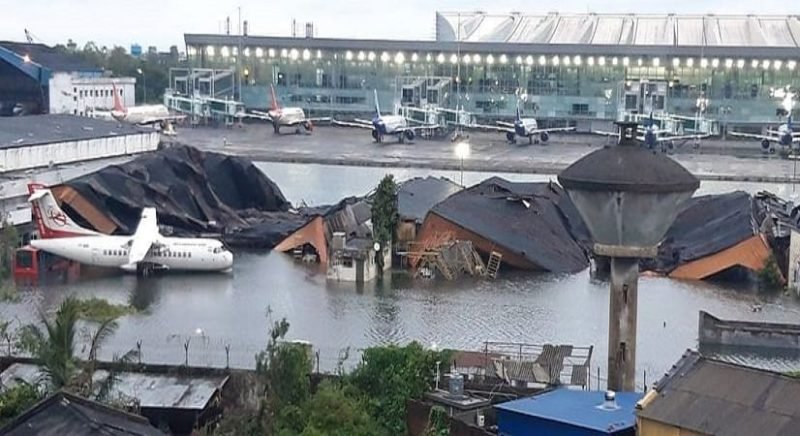Super cyclone ‘Amphan’ and the Government’s response towards mitigating the crisis

‘An unparalleled image: City of joy like never before’
One of India’s largest cities devastated by a turbulent cyclonic storm that raged with a monstrous fury after making landfall in India and Bangladesh on May 20, 2020.
When the entire world was already grappling with the lethal consequences of the deadly Coronavirus, Bengal was hit by a super cyclone- ‘Amphan’(pronounced um-pun) on May 20, 2020. This super cyclone, the first of its kind in Bengal since 1999, left millions without a roof over their heads. Resorting to prior alerts from the Indian Meteorological Department, around 500,000 people were evacuated from their homes of mud and thatch and shifted into storm shelters by the West Bengal government to prevent the cyclone from wreaking havoc. The cultural capital has now been confronted with what Chief Minister Mamata Banerjee has aptly described as ‘a bigger disaster than COVID 19’ and something that she has ‘never seen before.’ The situation that has followed is unfortunate and unprecedented.

Tropical cyclone Amphan marked its way out of the Bay of Bengal onto the land between Digha in West Bengal and Hatiya Islands in Bangladesh, roaring with gusty winds up to 185 kilometres per hour before weakening and moving further north, north-east. The ferocious storm made an anticipated landfall between 3:30 PM and 5:30 PM on Wednesday (May 20) absorbing the entire city in howls and fright. Today, Calcutta stands at the crosshairs of two disasters- the COVID 19 pandemic and the super cyclone Amphan. The past two days post the cyclone have been characterised by tragic images of various pockets of the city- dilapidated houses, roads enveloped in green leaves, citizens making their way through waterlogged streets coupled with power cuts, a significant dearth of water supply in most parts of the city and Calcuttans isolated from the rest of the world with their only mode of communication in a lockdown era (mobile phones), out of order.
Super cyclone ‘Amphan’ has claimed the lives of nearly 80 people in Bengal, with thousands of people rendered homeless. The storm raged with monstrous fury across the state destroying thousands of kutcha houses, devastating crops, livestock and farmlands, uprooting trees and electric poles in significant parts of the city- thereby turning the city of joy into one of pain and sorrow. The districts worst hit by the six-hour apocalyptic episode include both the North and South 24 Paraganas, Howrah and East Midnapore. With absolutely minimal national media coverage of the Bengal catastrophe (in spite of being reported by eminent international media houses) the main issues which come to the forefront are:
- The apathy of the Central Government towards lending a helping hand to the Bengal Government.
- Gradual irrelevance of a COVID fear in the midst of a cyclonic storm.
- Inexplicable damage to the largest mangrove forest- Sundarbans.

Loss of a COVID fear in the midst of a turbulent crisis
Standing at the crosshairs of two notable disasters, Bengal is in distress. Evacuation, keeping social distancing and hygiene protocols in mind, is an ordeal. Thousands of people who have already been accommodated in safe storm shelters and unaware of the damages inflicted by the storm will be faced with yet another devastation (the first still being a loss of livelihoods resultant of the lockdown). With fewer shelters available, they have been turned into quarantine homes. For thousands, this will be ‘an end of the world.’ Ensuring the lives and livelihoods of many while also adhering to safety protocols and regulating virus tests is the next challenge for the government.
Damage to the Sundarbans
The unwavering monstrosity of the cyclone has inflicted significant damage to the ecology of the world’s largest mangrove forest- the Sundarbans, a UNESCO world heritage site. Although a large number of people from the coastal and forest areas were shifted to safe shelters, the fragile wildlife remained exposed to the ferocity of the storm. Unlike its predecessors- ‘Aila’ or ‘Bulbul’, it caused irreparable damage to not only the wildlife but also affected the livelihoods of thousands, bursting mud embankments, breaking houses, bridges, lamp posts and felling innumerable trees. Such horrid accounts shall occupy an enormous space in the living memory of thousands.
A sudden shrink of federal responsibilities
To reiterate Congress President Sonia Gandhi’s comments made earlier in the day, the spirit of federalism has been forgotten as all power remains concentrated in the Prime Minister’s Office. The mainstream national media who remained silent on the Amphan issue for a considerably long time, coupled with the Centre’s apathy to respond to the catastrophe has been viewed as an unnecessary politicisation of a natural calamity. The internet has turned into a battleground between ‘Right-wingers’ and Bengalis with the former applauding Rs.1000 crore ($131.6 million) aid as a marvellous blessing to mankind. The dull Central response has been welcomed with an obligatory criticism which only further throws light on the constant predicament of the poor, whose misfortune lies at the hands of the authorities.
Today, Bengal is fighting on two fronts. Redemption from either of them will be a herculean task. How Bengal rebuilds itself and re-emerges from the brunt of such human disasters will be exemplary and remembered in the pages of history, much like the contributions of our four Nobel laureates, the reformation of Indian society helmed by Raja Ram Mohan Roy and even the lyrics of the Indian national anthem penned down by a Bengali.


















